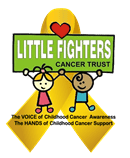Different kinds of cancer have different signs, symptoms, treatments, and outcomes, depending on the type of cell involved and the degree of uncontrolled cell growth. The most common childhood cancers are leukaemia, lymphoma, and brain cancer.
Below are links to the 12 main different Types of Childhood Cancers:
Click on the link to go to full article

Acute Lymphoblastic Leukaemia (ALL) which is also referred to as Acute Lymphocytic Leukaemia, affects the lymphoid cells and gets worse very quickly if not caught and treated early on. ALL affects children of any age but is mostly found in children aged 1-4 years, and in more boys than girls.

Acute Myeloid Leukaemia (AML) is also known as Acute Nonlymphocytic Leukaemia, Acute Myeloblastic Leukaemia, Acute Granulocytic Leukaemia, or Acute Myelogenous Leukaemia. AML occurs when the myeloid stem cells produce too many immature white blood cells called myeloblasts (or myeloid blasts). Leukaemia accounts for about 35% of all childhood cancers. Acute cancers get worse very quickly if they are not diagnosed and treated.

Brain Tumours can be either primary (develop in the brain) or secondary (cancer from another part of the body spreads to the brain). A primary brain tumour occurs when abnormal cells form in the tissues of the brain. Brain tumours are the most common type of tumour that develops in children, and they can affect children of any age. Slightly more boys than girls develop brain tumours.

Ewing’s Sarcoma is a bone cancer (although it can also very rarely develop in the soft tissue) and is the second most common primary sarcoma that can develop in children, comprising 10-15% of childhood bone cancers. Ewing’s sarcoma is not very common in younger children; it occurs mostly in the teenage years and is slightly more prevalent in boys.

Hepatoblastoma is a solid tumour cancer that develops in the soft tissue of the liver and accounts for almost half of liver cancers in children. The liver is situated in the upper part of the abdomen and is the largest organ in the body. The liver is very important as it performs vital bodily functions such as producing proteins that circulate in the blood. Hepatoblastoma does not usually spread outside the liver. It generally occurs in children younger than 3 years of age and affects slightly more boys than girls.

Hodgkin’s Lymphoma develops in the lymph system, which is an integral part of the body’s immune system. A malignancy in the lymph system can spread very quickly throughout the rest of the system. Lymphomas can start anywhere within the lymphatic system, but Hodgkin’s Lymphoma generally starts in the lymph nodes in the neck and more often in teenagers between 15 and 19 years of age.

Non-Hodgkin’s Lymphoma (NHL) develops in the lymph system, which is an integral part of the body’s immune system.NHL is the more common lymphoma in children; it is uncommon in children under the age of 10, but when it does, it is more common in boys than in girls. NHL generally occurs more often in children between the ages of 10 and 20.

Neuroblastoma occurs when malignant cancer cells form in the specialised nerve cells of the sympathetic nervous system called neural crest cells. These cells are involved in the development of the nervous system and other tissues. Neuroblastoma may be present at birth, but generally presents in early childhood, before the age of 5 years. In most cases, by the time it is diagnosed the cancer has usually already spread to areas outside of the original site, often to the lymph nodes, bones, bone marrow, liver, and skin.

Osteosarcoma (also called Osteogenic Sarcoma) is the most common type of bone cancer and starts in the osteoblasts, which are the bone cells at the end of the long bones where new bone tissue forms as a young person grows. Osteosarcoma is most prevalent in teenagers, and most often forms in the bones near the knees of children and teenagers or in the bones surrounding the shoulder joints. Most osteosarcomas occur in the centre of the bone.

Retinoblastoma is a type of eye cancer that develops in the light-sensitive lining of the eye, called the retina. Retinoblastoma can occur at any age but mainly occurs in children younger than 5 years of age and most often in those younger than 2. Retinoblastoma may occur in one or both eyes but rarely spreads to other parts of the body. Although it is the most common eye tumour in children, it is a rare childhood cancer and accounts for about 3-4% of childhood cancers.

Rhabdomyosarcoma is a soft tissue cancer that develops in the soft tissue of striated muscles, which are the muscles that are attached to bones and help the body move. Rhabdomyosarcoma accounts for about 50% of soft tissue sarcomas in children and can begin in various places in the body.is mostly found in children under the age of 10 and occurs in more boys than girls. If the tumour occurs in the head or neck area it may spread to the brain or the fluid surrounding the spinal cord.

Wilm’s Tumour is a cancer of the kidneys; it derives from specialised cells in the embryo known as metanephric blastema. These cells contribute to the development of the child’s kidneys while they’re in the womb and generally disappear at birth, but cells called nephrogenic rests can still be found in children with Wilms Tumour. Sometimes these cells begin to grow out of control, resulting in a mass of primitive, small, rapidly dividing cells called Wilms Tumour. This can affect only one kidney (unilateral) or both (bilateral). Wilms’ Tumour is the third most common childhood cancer and accounts for 6-7% of childhood cancer cases. It is most prevalent in children between the ages of 3 and 4 years. It may spread to the liver, lungs, or nearby lymph nodes.
